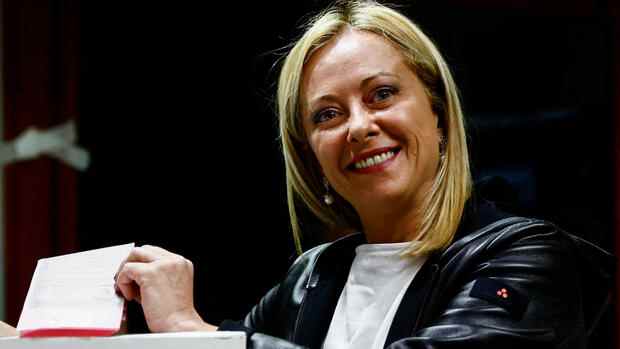Rome Giorgia Meloni is the winner of the Italian parliamentary elections: according to initial projections, her post-fascist party Fratelli d’Italia won the most votes. Their aspired alliance, which also includes Matteo Salvini’s right-wing Lega and ex-Prime Minister Silvio Berlusconi’s centre-right Forza Italia party, is likely to get more than half of the seats in parliament, as do TV channels Rai and SkyTG24 in reported consistently on Monday night. The polling stations were still open until 11 p.m., and the official final result is not expected until Monday morning.
However, the distance between Fratelli d’Italia (FDI) and the second-placed Social Democrats (PD) is around five percentage points, so great that victory can hardly be stolen from FDI founder Giorgia Meloni. As the head of the strongest party, the 45-year-old could lead the future government as Italy’s first female prime minister.
>> Read here: Risk of the Italian elections: the markets’ fear of a shift to the right
More than 50 million Italians were called to vote on Sunday. But fewer people went than ever before: voter turnout has fallen to a historically low level of just 64 percent. In the 2018 election it was around 73 percent.
Top jobs of the day
Find the best jobs now and
be notified by email.
The right-wing bloc had already gone into the election as the clear favorite and, according to the projections, together accounted for 41 to 45 percent of the votes. Since the direct mandates have a special weight in Italian electoral law and the right-wing parties have done very well there, they will probably get a clear majority in both chambers of parliament. According to the first projection, the Meloni Alliance has 116 of the 200 seats in the Senate. A majority of at least 233 of the 400 seats is expected in the larger Chamber of Deputies.
The centre-left parties are fragmented
The left-wing parties did not campaign as a united force against the right-wing alliance. The alliance of Social Democrats, left-wing parties and Greens came to 25.5 to 29.5 percent according to the forecasts. The left-wing Five Star Movement landed between 13.5 and 17.5 percent of the vote. The central alliance lagged behind at 6.5 to 8.5 percent.
Melonis Fratelli d’Italia (Brothers of Italy) were the only major opposition force in Parliament, while the “Coalition of National Unity” led by Prime Minister Mario Draghi ruled. It’s a remarkable rise: in the 2018 election, the radicals got just over four percent. Her decision not to join Draghi’s government allowed Meloni to further distinguish herself. Also because Lega and Forza Italia were part of the broad coalition, making FDI the only address for protest voters.
The party represents nationalist, EU-critical and sometimes racist positions. Meloni wants a “Europe of patriots” and is against, for example, giving homosexuals the right to adopt. She also spoke out decisively against migrants during the election campaign. The party, which was founded in 2012, has a flame in its national colors in its logo, which is intended to commemorate the fascist dictator Benito Mussolini.
>> Also interesting: EU President von der Leyen to Italy’s rights: “We have tools”
In Europe, many partners had looked with concern at a possible Meloni victory – also because the Roman announced that she wanted to discuss the use of billions of euros from the EU reconstruction fund and recently showed solidarity with Viktor Orban when the EU demoted the country to an autocracy .
The leader of the far-right Fratelli d’Italia party seems certain of victory.
(Photo: dpa)
Congratulations from AfD and PiS
Meloni received the first congratulations from Germany from the AfD: “We celebrate with Italy!” Wrote Beatrix von Storch, member of the Bundestag, on Twitter. Her party colleague Malte Kaufmann tweeted: “A good day for Italy – a good day for Europe.” Poland’s Prime Minister Mateusz Morawiecki from the right-wing conservative PiS party also congratulated. In Hungary, parliamentarians posted photos of Orban with Salvini, Meloni and Berlusconi.
On the other hand, Katharina Barley, Vice-President of the EU Parliament, was concerned: Meloni’s “election campaign tactical lip service for Europe” could not hide the fact that she posed a danger to constructive cooperation in Europe, the SPD politician told the “Welt”.
According to plan, the elections in Italy should not take place until the beginning of 2023. At the beginning of 2021, the centre-left coalition in power at the time broke up. Draghi, ex-head of the European Central Bank, was appointed head of government at the time without re-election. He initially ruled the country calmly and prudently through the Corona crisis. But since the beginning of this year, the quarrels in the multi-party coalition have continued to increase. In July, the Five Star Movement withdrew its confidence in the prime minister over a proposed law – and Draghi resigned. However, he will remain in office until a new government is sworn in.
Experience has shown that this can take several weeks in Italy: the constitution stipulates that the parliamentary groups must be formed by October 13th. Only then can the President instruct the Prime Minister-designate to form a government. According to experts and election observers, it should be at least 30 days after the election before Draghi is replaced in the Palazzo Chigi – as it currently looks by Meloni.
More: Alliance of Radicals: These right-wing parties want to govern Italy
